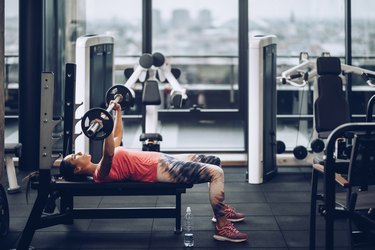
When it comes to chest-isolating exercises, the bench press is king. It's efficient and effective and allows for modifications to make the exercise easier or harder or to activate your pectoral from various angles.
But like with any exercise, proper form is the key to getting the most out of your bench press, no matter which modification you choose. And while standard practice has the feet planted firmly on the ground throughout the bench press, you may have seen some lifters with their feet elevated. So what's the correct way?
Video of the Day
Video of the Day
Feet Up or Down?
A June 2019 study published in PLOS One found that lifting your feet up and holding your legs at a 90-degree angle activates significantly more muscle than with feet down. The implication, then, is that this increased efficiency makes it an overall better exercise, right? Not so fast. The leg-up version isn't a one-size-fits-all solution.
"It's important to recognize the purpose of performing the exercise," says Adam Virgile, CSCS, sports science coordinator at The University of Vermont. In other words: What's your goal with the bench press?
"It is likely more common that powerlifting athletes and those focusing on overall strength capabilities perform the bench press with feet on the floor, whereas those who are more interested in development of upper body and core musculature may be more likely to perform the bench press with feet elevated."
If you're brand new to weight-lifting, you should always opt for the most stable version of an exercise first before progressing to something more challenging. In this case, that means feet on the floor.
Read more: Major Muscle Groups Used in Bench Press
Risks of the Legs-Up Bench Press
The additional muscle activation makes the legs-up position seem like a great option, but there are some risks. With your legs up as you press, you're no longer stabilizing yourself on the floor with your feet. You are basically balancing on your back alone. Since your legs are no longer able to catch you if you falter, there is a higher risk of losing your balance in this position.
Similarly, as your muscle exertion nears the failure point, you run the risk of getting stuck "under the bar" since your legs can't be used as a crutch to support the pushing effort. It's a good idea to use a spotter whenever you try a new exercise to help you navigate the new load on your muscles and coordination.
There's another reason to ask a spotter for help as well for your bench press exercises. A spotter not only helps you perform the exercise more safely, you also ultimately lift more weight, feel better about your performance and perform it more effectively, according to August 2019 research from the National Strength and Conditioning Association.
Read more: Alternative Exercises for Bench Pressing
How to Do a Standard Bench Press
In the basic bench press, your body forms a tripod of stabilization, between your back on the bench and both feet resting on the ground. While it primarily works the chest, it also requires support and stabilization from the shoulders, triceps, forearm, glutes and back. Here's how to do it properly:
- Lie face up on a flat bench with the bar above you on a rack. Grip the barbell with the hands slightly wider than shoulder-width.
- Press your feet into the ground and your hips into the bench while you lift the bar up and off the rack.
- Slowly lower the bar to your chest, allowing your elbows to bend out to the side, and stopping when your elbows are just below the bench.
- Press your feet into the floor and extend your arms, pressing the weight straight up to return to the starting position.
The legs-up bench press is done the same way but with the legs lifted and the knees and hips at 90-degree angles. With your your legs balanced in the air, each muscle group works harder than when legs are on the floor. Not only are the chest, shoulders, triceps, forearm, glutes and back activated to a greater extent, but the abdominal muscles and quads are really fired up in this position as well.
Other bench press modifications and variations could involve a change in grip, the incline (or decline) of the bench, the angle and position of the legs or whether you us one arm or alternate arms.
Regardless of the variation, proper breathing is a key component. When performing a bench press, exhale on the effort (i.e. as you press up). "Holding your breath can raise your blood pressure, and if you're pressing a lot of weight, this can lead to a blackout or fainting spell," says Sarah Gibson, MD, a physical medicine and rehabilitation specialist with the Nemours Foundation. Lower the bar carefully, taking a breath between each rep.
- Adam Virgile, Certified Strength and Conditioning Specialist (CSCS) and Sports Science Coordinator at The University of Vermont
- Evaluation and comparison of electromyographic activity in bench press with feet on the ground and active hip flexion
- ACE Fitness: Bench Press Grips
- https://kidshealth.org/en/teens/sport-safety.html
- Presence of Spotters